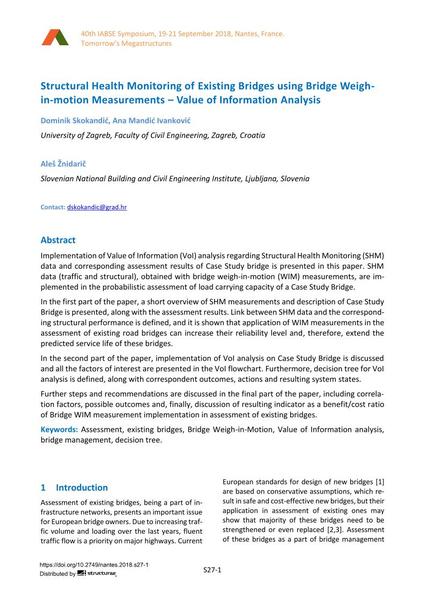Structural Health Monitoring of Existing Bridges using Bridge Weigh- in-motion Measurements – Value of Information Analysis

|
|
|||||||||||
Bibliografische Angaben
| Autor(en): |
Dominik Skokandić
(University of Zagreb, Faculty of Civil Engineering, Zagreb, Croatia)
Ana Mandić Ivanković Aleš Žnidarič (Slovenian National Building and Civil Engineering Institute, Ljubljana, Slovenia) |
||||
|---|---|---|---|---|---|
| Medium: | Tagungsbeitrag | ||||
| Sprache(n): | Englisch | ||||
| Tagung: | IABSE Symposium: Tomorrow’s Megastructures, Nantes, France, 19-21 September 2018 | ||||
| Veröffentlicht in: | IABSE Symposium Nantes 2018 | ||||
|
|||||
| Seite(n): | S27-1 | ||||
| Anzahl der Seiten (im PDF): | 8 | ||||
| DOI: | 10.2749/nantes.2018.s27-1 | ||||
| Abstrakt: |
Implementation of Value of Information (VoI) analysis regarding Structural Health Monitoring (SHM) data and corresponding assessment results of Case Study bridge is presented in this paper. SHM data (traffic and structural), obtained with bridge weigh-in-motion (WIM) measurements, are im- plemented in the probabilistic assessment of load carrying capacity of a Case Study Bridge. In the first part of the paper, a short overview of SHM measurements and description of Case Study Bridge is presented, along with the assessment results. Link between SHM data and the correspond- ing structural performance is defined, and it is shown that application of WIM measurements in the assessment of existing road bridges can increase their reliability level and, therefore, extend the predicted service life of these bridges. In the second part of the paper, implementation of VoI analysis on Case Study Bridge is discussed and all the factors of interest are presented in the VoI flowchart. Furthermore, decision tree for VoI analysis is defined, along with correspondent outcomes, actions and resulting system states. Further steps and recommendations are discussed in the final part of the paper, including correla- tion factors, possible outcomes and, finally, discussion of resulting indicator as a benefit/cost ratio of Bridge WIM measurement implementation in assessment of existing bridges. |
||||
| Stichwörter: |
Bewertung Brückenmanagement
|
||||
